Sound: 









Value: 









(Read about our ratings)
Measurements can be found by clicking this link.
With headphone amps available in so many configurations these days, it’s refreshing to find one as simple as the Topping A50s ($199.99, all prices USD). Simple amps are an increasingly good idea, because our ways of accessing music have been changing so fast. I remember about six years ago rolling my eyes while sharing a radio show with music industry guru Ted Cohen, who insisted that streaming would be the future of music distribution. Now I can’t remember the last time I listened to anything other than a streaming service. So while I can’t say how we’ll be listening to music in five years, I’m pretty sure that simple amps like the A50s will continue to work with any new source devices and technologies that might come along.
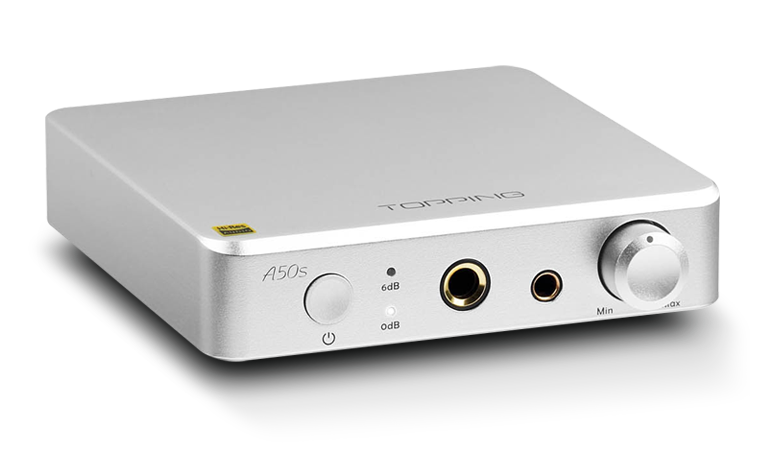
All an amp like the A50s needs to do is deliver power, and by its specs, at least, the A50s does that well: 3500mW into 32 ohms from the 1/6″ (4.4mm) balanced headphone output jack, at less than 1% total harmonic distortion plus noise. The rated power falls to 1400mW from the 1/4″ (6.3mm) unbalanced headphone output jack, but that’s still pretty impressive for such a small amp. To put these numbers in perspective, few headphones need more than 50mW to reach extremely loud levels.
Topping specs the A50s with an A-weighted signal-to-noise ratio of about 145dB. That’s a bold claim, considering that the best audio analyzer available, the Audio Precision APx555, has residual noise at about -143dB referenced to a 1kHz, 10Vrms balanced signal (equivalent to 3.1W into 32 ohms). (Topping claims to have measured the noise by boosting it by 100x, or 20dB, with an external amplifier and then dividing it by 100; the webpage for the A50s does show the measurements.) This has no appreciable effect on performance, though, because the noise floor of even mediocre solid-state audio electronics is difficult to hear, and even the best-engineered DACs are at least 15dB noisier than the A50s.
There’s not much else to the A50s. It has stereo RCA inputs and outputs. On the front is a button to turn on the power and select 0dB or 6dB gain (which translates to 6dB or 12dB for the balanced output). There’s also a volume control.
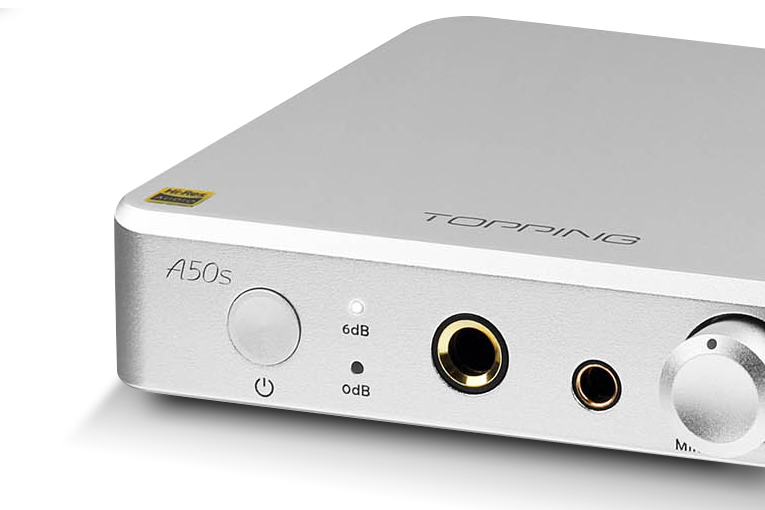
A separate 15V wall-wart power supply is included, and the amp is available in black or silver finish. Topping also offers a matching DAC, the D50s ($249.99), and an upgraded power supply, the P50 ($119.99).
In the box
You get the amp, the power supply, and a 1/4″-to-1/8″ headphone adapter.
Use
There’s little to say about the A50s from a basic operational standpoint. Plug in your source, plug in your headphones, turn on the power, and turn up the volume. Kick in the extra 6dB of gain if you need it. One thing I can say is that at just 4 9/16″ by 4 5/16″ by 1″, it doesn’t take up much space on the desktop.
However, when doing the output level vs. distortion measurements and when driving especially demanding headphones such as the HiFiMan HE6se’s to loud levels, I found that the A50s has a very aggressive protection circuit. The circuit appears to be thermally triggered. Running the amp at or near the threshold of the protection circuit for a minute or two tended to either shut the amp down entirely or trigger rapid clicking sounds (a relay, I assume) reminiscent of what it sounds like when you try to start your car with a nearly dead battery. Yet no distortion was audible before the amp shut itself down. Pausing playback on the signal source and turning the volume down often didn’t restore the sound; I assume the amp needs to cool down a bit before it’ll turn itself back on.
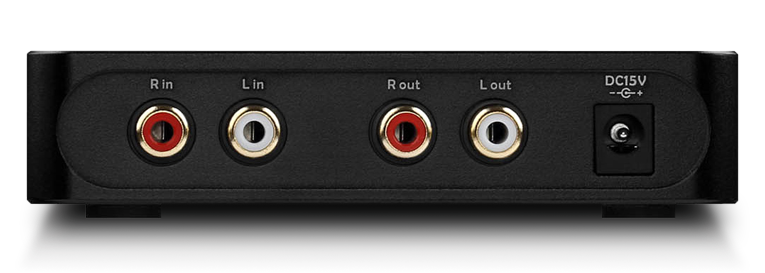
I encountered this when using the AudioQuest DragonFly Cobalt as a DAC, probably due in part to the Cobalt’s relatively high maximum output level (its output doubles as a headphone amp). Switching to a Musical Fidelity V90-DAC, which has a lower but still ample max output level, I was able to run the A50s at full volume into the HE6se’s for long periods of time. Therefore, you’re unlikely to encounter this problem unless you run very insensitive headphones, use a high-output DAC, and like your music loud. But still, it’s the first time I’ve seen a headphone amp do this. (Interestingly, I noted similar behavior when I tested the Topping MX3 stereo integrated amp for another publication.) Check the measurements section if you want to see how the protection circuit affects the A50s’s output.
Sound
Speaking of the HE6se’s, my first test of an amp is to find out whether it can drive these notoriously (and intentionally) insensitive cans to loud levels. The A50s can, within the limitations noted above. Playing the wonderful album Faune, by the Raphaël Pannier Quartet (320kbps Ogg Vorbis, French Paradox / Spotify), the A50s was able to deliver a fairly loud (and to my ears, just right) listening level with the HE6se’s when the amp’s volume was set to max and the gain to +6. The fleet-fingered double bassist François Moutin’s tone sounded just as I’d imagine such a bassist would want to sound: clear but full-bodied, powerful, and grooving. I heard no strain whatsoever from the headphones or the amp, and the HE6se headphones’ slight tendency toward brightness wasn’t evident as it was with amps that struggle to drive them.
When I switched to the Audeze LCD-Xes, the A50s seemed to preserve those headphones’ punchy and powerful but somewhat soft-in-the-mids tonal balance. Holly Cole’s recording of “Good Time Charlie’s Got the Blues” (Night, 16/44.1 WAV, Tradition & Moderne) sounded natural overall, and perhaps balanced a little toward the mellow side. I heard the same basic tonality from jazz guitarist Emily Remler’s beautiful version of Antonio Carlos Jobim’s “Look to the Sky” (Firefly, 16-bit/44.1kHz WAV, Concord Jazz). The balance was very nice overall, with slightly less twang on the attack of her notes than I’m used to hearing.
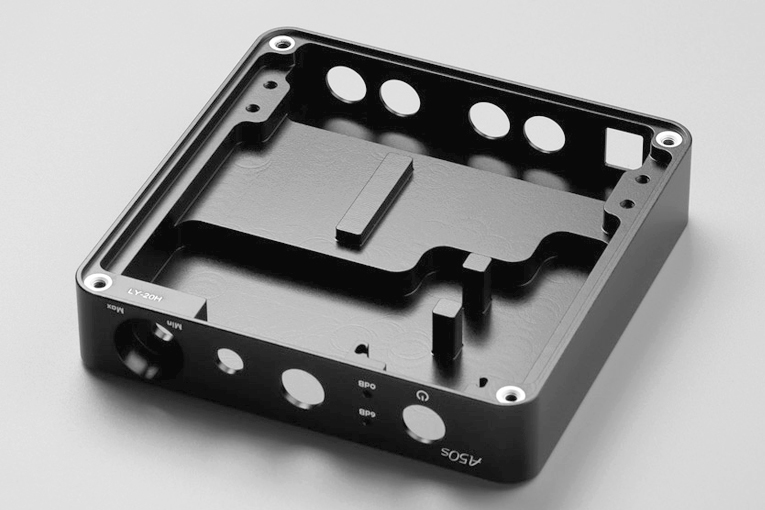
With heavier fare (the LCD-Xes’ real strength), the A50s sounded right on the money. On the title track of Metallica’s Master of Puppets (320kbps Ogg Vorbis, Elektra/Spotify), the A50s had plenty enough power to get the LCD-Xes’ big planar drivers moving (and stopping) at the right times, with no distortion I could hear and nothing in the mix accentuated or diminished.
I wanted to hear how the A50s sounded with earphones (and to see if it had any audible noise), so I grabbed the Meze Rai Pentas. Listening to one of my favorite straight-ahead jazz releases of the last few years, Los Angeles jazz drummer Paul Kreibich’s Thank You Elvin (16/44.1 WAV, Blujazz), I heard no noise at all, and the tonal balance of the A50s seemed an ideal fit for the Rai Pentas. I loved the way the triple-tenor-saxophone romp “Triple Play” sounded, along with the way the A50s / Rai Penta combination precisely imaged the three saxes (one left, one center, one right) and captured the subtleties of Kreibich’s deft touch on the snare and ride cymbal.
Comparison
To me, the obvious amp to compare with the A50s is the Schiit Magnius, because both are just amps (no DAC) and both cost the same. They even have the same front panel jacks and controls, except the Magnius has a four-pin XLR balanced out instead of the A50s’s 4.4mm balanced out. The Magnius is about four times as large by volume, so it doesn’t fit as easily on a desk, but the Magnius also adds stereo XLR inputs in addition to stereo RCA inputs. I fed them both from the V90-DAC and matched their levels to within 0.02dB using the Beyerdynamic T5 third-generation headphones.
Both of these are good amps; when set to full volume, both have enough power to get the HiFiMan HE6se’s cranking nicely with most material. The differences I heard were that the Magnius seemed to sound a little brighter in the treble, while the A50s sounded subtly softer—and that the bass of the A50s was slightly fatter sounding.
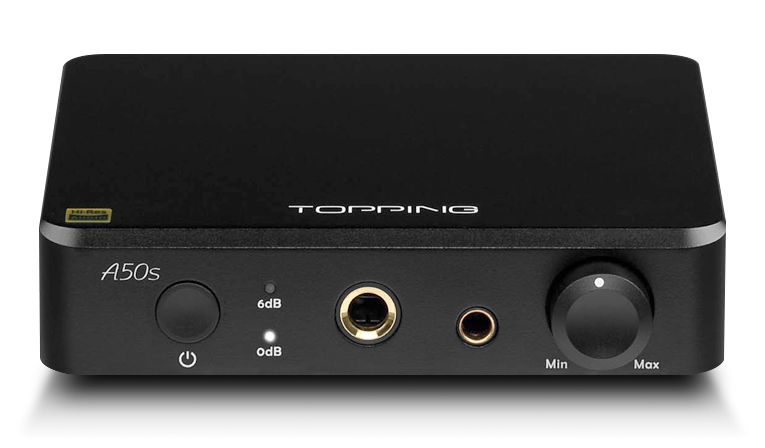
On bassist/singer Casey Abrams’s fantastic version of “Take the A Train” (Put a Spell on You, 24/96 AIFF, Chesky), both amps sounded good, and both delivered a nice sense of the recording space—as they must in this case, since it’s one of Chesky’s Binaural+ recordings. But the A50s gave me a little bit fuller of a sound from Abrams’s double bass, creating the psychoacoustic effect of slightly de-emphasizing his plucking sounds and string noises. The Magnius also seemed to give me a little extra hint of breath from Jacob Scesney’s tenor saxophone.
Conclusion
The A50s is a nice little amp for those who want to drive demanding headphones in a desktop setup where space is at a premium—I imagine it would work well in desktop audio production setups, cubicles, dorm rooms, and anywhere else space is tight. With a few limitations I’ve noted, it can drive almost any headphones. And as my measurements show, it’s obvious that a lot of care went into its engineering.
. . . Brent Butterworth
Associated Equipment
- Headphones: Audeze LCD-X, Beyerdynamic T5, HiFiMan HE6se
- Earphones: Meze Rai Penta
- Laptop: Lenovo IdeaPad Flex 5-1470
- DACs: AudioQuest DragonFly Cobalt, Musical Fidelity V90-DAC
Topping A50s Headphone Amplifier
Price: $199.99 USD.
Warranty: One year parts and labor.
Topping Audio
26th Jiaomen Road, Huangge,
Nansha, Guangzhou, China 511455
Phone: (+86) 20-37219489
Website: www.tpdz.net
Apos Inc.
6050 Lowell St., #111
Oakland, CA 94608
Phone: 510-858-6585
Website: apos.audio





